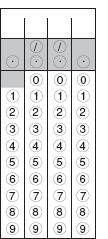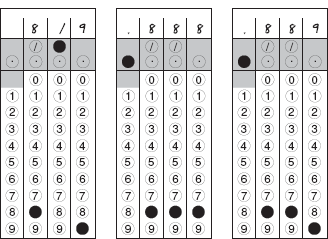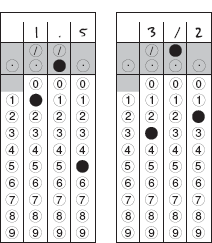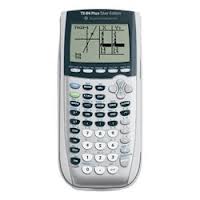|
|
|
The SAT is a standardized test used by colleges to gauge students' academic abilities. The mere mention of the SAT instils a feeling of dread in many high school students. The exam has caused a lot of controversy in past years, so much so, that some colleges don't even have an SAT score requirement. Love it or hate it - and you probably hate it - the SAT is an obstacle you have to overcome if you want to get into the Ivy league school of your choice. The SAT consists of ten parts. There are three math sections, three critical reading sections, two writing sections, one essay, and an experimental section which may be math or verbal. Each section begins with some directions. SAT Math: As I tutor SAT math, I will be focusing on the math sections of the SAT. Just as the verbal sections do, each math section begins with some directions along with a small list of basic formulas. These include some area and volume formulas, the Pythagorean Theorem, and two special triangles. Each of the three math sections has a different number of questions. (A) A 20 question multiple choice section - you have 25 minutes to complete this part. (B) A 16 question multiple choice section - you have 20 minutes to complete this part. (C) An 18 question section with 8 multiple choice questions followed by 10 "grid-in" questions - you have 25 minutes to complete this part.
These sections can appear in any order on the SAT. Multiple choice questions: Each multiple choice question comes with five choices. You get one point added to your raw score for each of these questions you get right, and unfortunately, you lose a quarter of a point for each one you get wrong. The quarter point penalty is to ensure that random guessing will not help your score. Grid-in questions: The "grid-in" questions require a free response. At first, answering these questions can seem confusing, but it will become straightforward with a bit of practice. On your answer sheet there are four columns with space on top to write your answers, and there are bubbles below. The computer only grades what you have marked in the bubbles. The space above the bubbles is just for your convenience, and to help you do your bubbling correctly. Never mark more than one circle in a column or the problem will automatically be marked wrong. You do not need to use all four columns. If you don't use a column just leave it blank.
The symbols that you can grid in are the digits 0 through 9, a decimal point, and a division symbol for fractions. Note that there is no negative symbol. So answers to grid-ins cannot be negative. There are only four slots, so you can't get an answer such as 52,326. Sometimes there is more than one correct answer to a grid-in question. Simply choose one of them to grid-in. Never try to fit more than one answer into the grid. If your answer is a whole number such as 2451 or a decimal that only requires four or less slots such as 2.36, then simply enter the number starting at any column. The two examples just written must be started in the first column, but the number 16 can be entered starting in column 1, 2 or 3. There is no zero in column 1, so if your answer is 0 it must be gridded into column 2, 3 or 4. Fractions can be gridded in any form as long as there are enough slots. The fraction 2/100 must be reduced to 1/50 simply because the first representation won't fit in the grid. Fractions can be converted to decimals before being gridded in. If a decimal cannot fit in the grid, then you can simply truncate it to fit. To truncate is to simply remove any numbers after the four slots have been filled. But you must use every slot in this case. For example, the decimal .167777777... can be gridded as .167, but .16 or .17 would both be marked wrong. Instead of truncating decimals you can also round them. For example, the decimal .167777777... can be gridded as .168. I like truncating better than rounding because there is no thinking involved and you are less likely to make a careless error.
Here are three ways to grid in the number 8/9:
Never grid-in mixed numerals. If your answer is 2 ¼, and you grid in the mixed numeral 2 ¼, then this will be read as 21/4 and will be marked wrong. You must either grid in the decimal 2.25 or the improper fraction 9/4.
Here are two ways to grid in the mixed numeral 1 ½ correctly:
There is no guessing penalty for grid-ins, so you shouldn't ever leave these blank. Math topics covered: There are four main math problem types on the SAT
Not everything tested on the SAT falls into one of these categories exactly, but this is close enough for our purposes. For example, counting problems appear on the test - I always group these with Probability and Statistics. As I always say, you most likely have all the mathematical knowledge you need already. So there is no need to relearn any mathematical theory. Reviewing these topics will happen naturally as you practice SAT math problems. This does not mean that you don't need to study. Many SAT questions are intentionally designed to trick you. Therefore you will still need to prepare. But your emphasis should be on learning SAT specific strategies, and practicing SAT math problems. Difficulty level: Math questions on the SAT come in 5 levels of difficulty. Level 1 questions are very straightforward, and Level 5 questions are usually quite tricky and may involve two or more steps to get to a solution. Each math section roughly progresses in difficulty from Level 1 to Level 5. I like to think of each math section as being split into three parts - the first third being easy, the middle third medium, and the last third hard. The 18 question section would then actually have six parts - three for the multiple choice questions and three for the grid-ins. In other words, the eight multiple choice questions go from easy to hard, and then number nine is an easy grid-in question. The grid-ins then get progressively harder up to number 18. Calculator use: You can use a calculator on the SAT. I recommend using a TI-84 or something comparable.
Make sure you consistently practice with the calculator you plan to use. This way you will be comfortable with it on test day. SAT score: You get one point added to your raw score for each question you get right. You lose a quarter of a point for each multiple choice question you get wrong. You are not penalized for getting a grid-in question wrong. You can get your raw score by typing the following into your calculator: c - w/4 where c is the number of questions you got right and w is the number of multiple choice questions you got wrong. You should then round this number to the nearest whole number to get your raw score. From there, each SAT has its own conversion chart that turns your raw score into your scaled math score. This is a number between 200 and 800. To get an 800 in math you usually have to get every question correct. Once in a while there is an SAT where you can miss one question and still get a perfect score. Best of luck, 
Dr. Steve Dr. Steve is a Staten Island (NY) native, who earned his Ph.D. at Rutgers University in Pure Mathematics in May, 2001. While a graduate student, Dr. Steve won the TA Teaching Excellence Award. After Rutgers, Dr. Steve joined the Penn State Mathematics Department as an Assistant Professor. In September, 2002, Dr. Steve returned to New York to accept an Assistant Professor position at Hofstra University. By September 2007, Dr. Steve had received tenure and was promoted to Associate Professor. He has taught undergraduate and graduate courses in Precalculus, Calculus, Linear Algebra, Differential Equations, Mathematical Logic, Real and Complex Analysis, Set Theory and Abstract Algebra. Over that time, Dr. Steve participated in a five year NSF grant, "The MSTP Project," to study and improve mathematics and science curriculum in poorly performing junior high schools. He also published several articles in scholarly journals, specifically on Mathematical Logic. Dr. Steve began tutoring mathematics over 15 years ago. He has been tutoring for standardized tests, the SAT in particular, both individually and in group settings for over 10 years. His SAT math prep classes have been extremely effective in raising student SAT math scores, usually well over 100 points, and several of his students have received perfect SAT math scores. Dr. Steve is the author of books such as The 32 Most Effective SAT Math Strategies, which can be found at his website www.TheSATMathPrep.com. |




